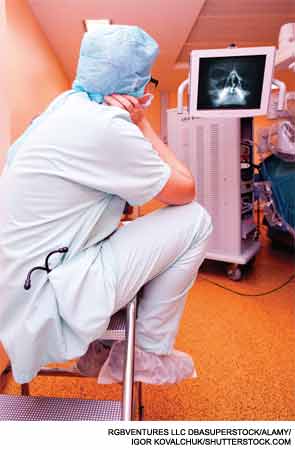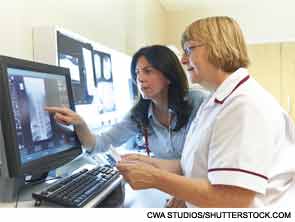
In the 50 years since the first telemedicine (TM) systems were put in place, bringing specialty medicine to underserved rural areas, there has been an evolution from imaging and laboratory results to video teleconferencing and beyond.
Explore This Issue
September 2013“Telemedicine is broadly defined as providing patient services using telecommunication,” said Jonathan Linkous, CEO of the American Telemedicine Association in Washington, DC. “Starting in the ’60s and ’70s, there were demonstration projects of point-to-point video to see a patient remotely. At the same time, there was a push toward digitizing medical imaging, eliminating the need to have the films available.”
This led to the adoption of store-and-forward programs in which X-rays and other information could be gathered in one place, stored in digital form in another and accessed by a provider in a third. If you have received an e-mail with a relative’s picture attached, you have experienced the family equivalent.
Patient Access
So far, TM programs have been used to provide access to patients in underserved areas and are often the only way these services can be provided. “Telemedicine has flourished most often when there is not an adequate distribution of otolaryngologists for a certain area,” said Michael Holtel, MD, who recently retired as a subject matter expert for the U.S. Army’s Telemedicine and Advanced Technology Research Center. “Rural practices, or where there is only one physician for a large geographical area, are when TM does best,” Dr. Holtel said.
It has also helped physicians and patients make more efficient use of their time. “We used to fly patients in from remote areas to be seen,” said John F. Kokesh, MD, medical director of the department of otolaryngology at the Alaska Native Medical Center in Anchorage. “If they needed surgery, we would fly them home until there was an opening. They would then fly back to Anchorage at a large expense to both the system and the patient.”
Now, local providers send clinical information ahead of time. A physician reviews the results and decides on a course of treatment. If it can be handled at home, the local provider is contacted with suggestions. If surgery is required, patients only need to travel to Anchorage once.
Telemedicine in Otolaryngology
Otolaryngology may be especially well suited to TM protocols. “A lot of what we do is digitized already, so when sitting next to the patient, we are looking at a video screen,” said Moisés A. Arriaga, MD, MBA, FACS, director of otology-neurotology and professor of otolaryngology and neurosurgery at Louisiana State University and director of Our Lady of the Lake Hearing and Balance Center, both in New Orleans. “After information is digitized, it doesn’t matter if the physician is in the room or halfway around the world,” Dr. Arriaga said.
As with other aspects of our lives, the focus and usability of TM is changing rapidly. In addition to videoconferencing between physicians and patients and store-and-forward technology, programs and applications have been developed to use diagnostic tools remotely and perform real-time monitoring.
“Today, most of us have advanced teleconferencing capabilities in our pockets,” said Stephen McCallister, CPHIT, CPEHR, an independent consultant with MGMA Health Care Consulting Group in Seattle. “Even if a physician isn’t going to talk to a patient through their smartphone, Skype and other technologies are familiar, and people are comfortable using them.”
Physicians note that the adoption of technology by patients may soon be a driving force in TM. “Patients are going to start driving telemedicine in ways we never anticipated,” said Dr. Kokesh. “The big difference is that everyone has a telemedicine device in their pocket. They are going to expect that their doctors participate with them in TM.”
Medicine has been slow to embrace changes taking place in other areas. For example, who would do business with a bank that did not offer automatic tellers and made you go to their offices to get your money? Convenient access to the physician will be an important consideration for patients.
Societal Changes Driving TM
In addition to technology, societal changes may play a role. For example, employers often put vacation and sick time in the same bucket of hours, forcing many patients to sacrifice vacation time in order to visit a doctor’s office. More recently, employers are starting to see an advantage in TM services for themselves.
Dr. Holtel, an otolaryngologist in San Diego, where there is a large
managed-care population, said employers are increasingly interested in providing clinical services through TM connections at their facilities so that employees can “see” a doctor and return to work faster.
Reducing patients’ need to physically visit a physician’s office will become increasingly important as the U.S. population ages and smaller practices fold into larger, urban-based ones, say some TM service experts. “In order to preserve market share, we need to lessen the burden of patient access to the practice,” said Nina M. Antoniotti, RN, MBA, PhD, director of TeleHealth Business at the Marshfield Clinics in Marshfield, Wis. “If TM’s only job is to alleviate patient difficulties in accessing a practice, that alone is a good enough reason to implement it.”
Overall, the general direction of medicine is seen as favorable to the use of TM. The aging U.S. population means there will be more patients and fewer active physicians, which could mean the need for remote treatment options to cover larger areas of the country. If practices continue to consolidate, TM may become a viable option in suburban or smaller urban areas.
—John F. Kokesh, MD
Health Care Reform
“As health care reform moves toward payment methods other than fee-for-service, TM may help practices increase their efficiency,” said Dr. Holtel. “As incentives change toward keeping people out of hospitals and telemedicine helps to monitor or follow people in their homes and keep them from getting sicker, the easier that goal could be reached.”
The services a practice uses, and the order in which they are rolled out, depends on what the physicians want to accomplish and the operating environment. For areas where appointment books are full, Web portals or other patient-access technologies may be a good first entry point. If there is white space in your appointment book, employing store-and-forward programs or videoconferencing to increase referrals may be a better use of a practice’s resources.
“One mistake practices make is buying telemedicine equipment and then deciding what to do with it,” said Dr. Antoniotti. “You first need to understand your clinical practice and what you want to accomplish. Find the markets you want to serve and then look for the technology that best services them.”

Look to Current Workflow
Practices should look closely at their current workflow and methods and replicate them in the virtual space. Consider staffing needed at the remote site and the types of services that will be provided. “The remote site will need a telepresenter trained in the use of equipment such as a video otoscope,” said Dr. Antoniotti. “This is usually an RN, although it might be a primary care doctor if the clinic is co-located with them. It is seldom that this person is used full-time in this capacity.”
Instituting TM is no different from opening up any other office. You will need to do staff credentialing, find an appropriate facility, buy the equipment needed and make sure necessary training is completed.
The associated costs are largely related to buying the equipment. As a general rule of thumb, initial outlays are likely to be around $10,000 to set up a patient exam room. This includes the video system, patient camera and instruments such as an otoscope. The bulk of the costs for a broadband connection and information technology assistance are already included in a practice’s infrastructure and are marginal.
“At Marshfield we have 45 clinical services, encompassing 250 clinicians at 75 sites in our network using TM every day,” said Dr. Antoniotti. “Yet we are able to run one of the biggest programs with only 1.8 full-time employees.”
—Nina M. Antoniotti, RN, MBA, PhD
Payment Issues
Payment issues under a TM system are an important consideration, and practice staff members should talk to coders and payers to find out how they need to be paid and how payments need to be documented through the new technology.
“Telemedicine doesn’t really fit well into the current evaluation and management coding system,” said Dr. Kokesh. “As we go forward, we will have to work out new ways to get suitable reimbursement.”
Likewise, TM will likely play a role in driving patients to the practice, both directly and through referrals in the future, say physicians. “Telemedicine is a tool, and figuring out how it best fits into a practice is an important question going forward,” said Dr. Holtel.
Leave a Reply